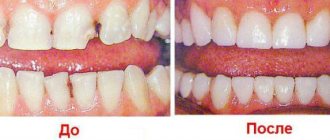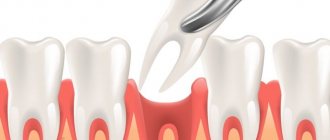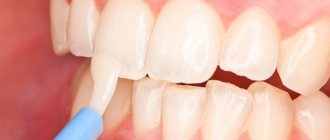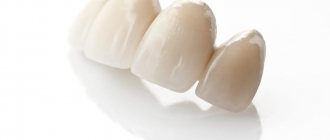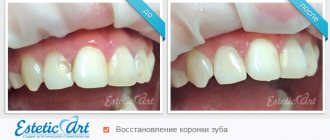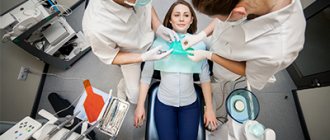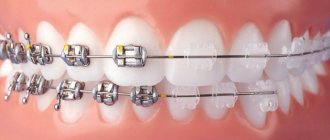- Why and when is extension needed?
- Main indications for extensions
- Extension techniques
- How to grow your front teeth?
- Advantages and disadvantages of extensions
- Contraindications
- FAQ
- Price
- Reviews
Dental augmentation is an effective procedure that can eliminate a number of dental defects most simply and quickly, without resorting to implantation.
It is especially in demand when it comes to the front teeth, the appearance of which ensures the aesthetics of the entire smile area. It is important that if you follow the recommendations, the result obtained will be long-term and will allow you to solve the existing problem for many years. For one patient, the use of such a tooth will be 5, for another – 10 or 20 years. How long an extended tooth lasts depends on many factors, the technique and materials used, the skill of the dentist, and the products included in the diet. Care will also play an important role. Due to the consumption of coffee, red wine, or smoking, the color may change, which will require a repeat event.
At the same time, restoring a tooth without a pin will make it possible to guarantee a longer service life. However, in a number of cases, it will not be possible to do without the use of such a technique to strengthen the affected tooth.
What is extension
Tooth augmentation is a dental procedure that involves restoring the lost crown using special dental composite materials. This manipulation is used to solve therapeutic and aesthetic problems in both adult and pediatric dentistry. It is quite popular due to its relative speed and cost-effectiveness, especially in comparison with more complex and invasive procedures such as the installation of crowns or veneers [1].
What to do if a child's baby tooth breaks off
- Is the child scared and crying? Try to calm him down. Take it in your arms, turn on your favorite cartoon or distract your baby with a game.
- If there is bleeding, apply a sterile gauze pad (do not use cotton wool - the fibers may stick to the chip).
- Try to find the tooth fragment as quickly as possible. Place it in saline solution, boiled water or wrap it in a damp cloth. This will make it easier to restore a child’s broken baby tooth.
- For pain, you can give Nurofen or paracetamol.
- If a fracture is suspected, make a circular bandage around the head, securing the lower jaw.
It is necessary to get an appointment with a dentist within the first 2-48 hours. Don't forget to take the saved tooth fragment with you.
In what cases is extension applied?
Despite the fact that tooth tissues have high density and strength, they can be destroyed for various reasons.
Firstly, pulpless teeth are often subject to destruction. Once the nerves are removed, they are no longer supplied with nutrition, their tissues demineralize and become fragile. Fragments can break off from the edges or chewing surface, and subsequently the teeth can become significantly damaged.
Secondly, teeth can be severely damaged from sports or household trauma, from chewing or biting off very hard food. In such cases, small chips of the edges, chewing surfaces, and cracks are common [2]. Children's front teeth often suffer due to accidental injuries.
In these cases, tooth augmentation helps restore the lost part of a broken tooth, in which the missing fragments are molded by a specialist from a composite material [2]. Front teeth augmentation is also successfully used in pediatric dentistry, where, thanks to modern materials and methods, pediatric specialists are able to restore a damaged tooth, which reliably serves the little patient until it is replaced with a permanent one.
Some dental procedures may expose the root. In this case, extensions help cover the sensitive area.
In addition, the extension procedure is also used in aesthetic dentistry to eliminate certain defects. Among them [3].
- difference due to anatomical and physiological characteristics of the shape, size, length of an individual tooth in a row;
- difference in tooth color;
- the presence of large interdental spaces;
- defects in the closure of the dentition.
Dental bonding is the most appropriate way to restore chipped teeth
“The 8 Best Ways to Improve Your Smile” American Dental Association
Indications and contraindications
Depending on the chosen method of teeth extension, indications and contraindications for each specific technique should be determined by your dentist. In this situation, you should not be guided solely by your taste preferences. Otherwise, your uncompromising demand: “I want veneers!” may lead to the fact that the treatment will not bring the desired effect, and the money will be wasted. Don't forget: everything is individual. For example, extensions using photopolymers are not practiced if there is severe tooth mobility. It is also recommended to avoid veneering for those patients who suffer from periodontal disease or do not have the necessary dental hygiene skills.
Main indications for extensions
- Cracks and chips
Microdamages caused by trauma. - Damage to the crown
If the dental crown is deformed or broken. - Consequences of caries
In case of advanced caries, when the tooth root is intact, but the area for filling is too large. - Gaps between teeth
Diastema, which negatively affects aesthetics. - Changing the color of the enamel A
dental defect such as fluorosis - white spots on the surface of the tooth enamel - cannot be eliminated with whitening, but can be corrected with extensions. - Increased tooth abrasion
As a result of demineralization of tooth enamel or a hereditary factor. - Malocclusion
Effective for mild defects in the occlusion of the dentition.
Absolute contraindications to extensions
- Maximum damage to the tooth
If the tooth is destroyed by more than 30%, the extension will not give a positive result. - Allergy
An allergic reaction to individual components of filling materials is rare, but its presence makes extension impossible. - Bruxism
Night and daytime teeth grinding will definitely lead to the destruction of the extended tooth. - Unsuccessful tooth localization
If the tooth is located in such a way that it cannot be isolated from saliva during the procedure, which neutralizes its result.
Make an appointment
right now!
Fedorova Yana Valentinovna
Therapist, Hygienist
How does tooth growth occur?
Tooth augmentation is a professional dental procedure that is performed by a specialist exclusively in the clinic. The durability and effectiveness of eliminating a cosmetic defect depends on the quality of its implementation. Therefore, any manipulations must ensure high aesthetics, mechanical strength and reliable adhesion of the extension to its own tissues [4].
Before starting the procedure, a general examination of the oral cavity is necessary. If necessary, the dentist provides professional cleaning and treatment, such as removing cavities.
Building up chewing teeth has its own characteristics. If the coronal part is severely damaged, a pin made of inert metal is used. It is installed in the pulpless root canal and serves as a support for the filling, which becomes part of the restored tooth.
Composite materials that are used for tooth extension are photopolymers, special resins with various fillers that easily harden when exposed to light from special lamps. Materials for tooth augmentation are constantly being improved by specialists and manufacturers; the latest generations of photocomposites are especially durable [5].
Before applying the composite material, the specialist prepares the surface. He makes it slightly rough and coats it with a special binding liquid. This is done so that the composite material and the tooth’s own tissue are better connected to each other. In this case, the strength of the extended tooth will be higher. If the photopolymer is applied without errors, the restored part may become detached from the tooth over time, and microscopic gaps or cracks may appear at the edge of the buildup [6].
An important stage of the procedure is selecting the shade of the composite material to match the color enamel . After which the specialist applies photopolymer, forming the required fragment. The material is exposed to light from a special lamp and hardens. As a rule, in modern dentistry layer-by-layer application of the material is used [5]. This technique allows you to make the extension especially durable.
After the lost part has been restored and the material has completely hardened, it is ground to correct the shape and then polished. The dentist checks whether the teeth are closed correctly after the procedure. If the patient feels discomfort, the specialist must sand off any unevenness or roughness.
The service life of the extension depends on many factors, for example, the patient’s nutritional habits, the type of photocomposite, or the quality of the procedure performed. On average, a restored tooth can last from 3 to 10 years [3].
Treatment of cracked teeth in children
The choice of treatment method depends on the age of the child, type of tooth (baby or permanent), location, depth and extent of the defect. Dentists have the following options at their disposal:
- grinding and polishing of enamel followed by application of protective and remineralizing components;
- restoration with filling material;
- installation of a veneer or crown (on a permanent bite);
- removal of a problematic tooth.
Simultaneously with the immediate elimination of the defect, the provoking factor is treated: nutritional correction, saturation of the enamel with minerals, etc.
Advantages and disadvantages of the tooth augmentation procedure
The advantages of extensions include the cost-effectiveness and simplicity of the procedure, and its low invasiveness. It does not require turning or depulping, which means that hard tissues are preserved as much as possible [5]. At the same time, extensions allow you to restore the aesthetically attractive appearance of your smile.
Typically, no anesthesia is used for the procedure, and the procedure itself takes 30-60 minutes [3] and can be performed in just one visit to the dentist.
The disadvantages of building up are associated with the lower density and strength of composite materials in comparison with dental tissues, and their relative porosity [5]. Therefore, the restored parts may become stained, chipped or damaged when eating hard foods such as crackers or nuts [1].
Prevention
No one is immune from accidental dental injuries. To minimize the likelihood of crack formation, you must:
- adhere to a diet with sufficient calcium, fluorine, and other microelements;
- avoid situations where the tooth is exposed to stress (do not chew nuts, do not try to open bottles with your teeth);
- do not try to whiten enamel at home, including using abrasive pastes;
- Visit your dentist regularly for monitoring.
A cracked tooth is an unpleasant occurrence for both children and adults, but it can and should be dealt with. The Department of Dentistry of the SM-Doctor clinic invites very young patients and teenagers to visit. We will find obvious and hidden defects in tooth enamel and select effective treatment. Call and make an appointment with the dentist now.
Caring for an extended tooth
Patients who have had to have a tooth augmented need to carefully follow the rules of oral care and also get rid of some bad habits [1].
First, you should avoid eating solid foods, such as nuts, hard cookies, crackers, and candies. In addition, you need to get rid of the habit of chewing a pencil or pen.
Secondly, do not forget that composite materials can be painted more easily than enamel, which means you should avoid brightly colored drinks such as coffee and tea, fruit and berry juices, and red wine. Smoking can also ruin the color of your extensions. It is especially important to follow this rule during the first days after the procedure [1].
Thirdly, it is necessary to follow the general rules of oral hygiene: brush your teeth at least 2 times a day, use a soft-bristled toothbrush, toothpaste and mouth rinse with fluoride, as well as dental floss to clean the interdental spaces.
Fourthly, it is important to visit the dentist at least once every six months, not forgetting the importance of regular professional cleaning procedures. You should know that restored teeth need especially careful polishing.
If you notice an unpleasant sensation in the mouth at the site of the restored tooth, for example, a scratching edge or a suspected chip of the composite material, you should immediately contact your dentist for an examination.
Types of injuries to baby teeth
To choose a method to restore a broken baby tooth, you first need to determine the type of injury.
Chip on a baby tooth
A chip can occur from minor damage: a child grinds his teeth in his sleep (a common sign of helminth infection), ate solid food (crackers) or chewed a pencil, or bit a spoon unsuccessfully. When examining the oral cavity, it is discovered that a piece of the child’s baby tooth has broken off, the lower edge of the crown has become uneven and scratches the tongue. In this case, it is important to determine the extent of the damage.
If a red dot is visible on the surface of the chip, then the injury is serious and affects the pulp (nerve). And although the child will complain of acute pain when eating cold/hot food, the broken tooth can be saved.
Horizontal crack
A crack indicates an incomplete fracture of the tooth. The baby tooth has not cracked, but the crown is loose, and when the teeth are closed and biting, a sharp pain appears. The most difficult case is when the child fell, the tooth did not break off, but a crack appeared on the crown along the edge of the gum. In this case, you will likely need to strengthen the tooth with a thin veneer.
Baby tooth broken at the root
Did the kid bring a broken tooth in his hand? Unfortunately, with such an injury, it will not be possible to restore the integrity of the dentition. However, you still need to go to the dentist in order to remove the remaining fragments from the gums.
Impacted tooth fracture
With such an injury, the tooth is partially immersed in the gum. The length of the tooth is reduced compared to other crowns, but its edge is not sharp and does not scratch. Characterized by diffuse pain in the jaw. Sometimes the injury is accompanied by heavy bleeding due to the many small vessels in the gums of children.
Fractures of the alveolar process and jaw due to impacted tooth trauma are extremely rare, since the roots of baby teeth are quite short. Damage to bone tissue is indicated by severe pain spreading throughout the entire jaw on one side, the inability to open the mouth wide and a change in the bite.
Displacement of a baby tooth
With a strong blow, damage to the coronal part may be accompanied by complete or incomplete dislocation. A child’s tooth (often a front one) breaks off and takes an unusual position in the socket: it moves to the side, moves forward or backward, and turns around its axis. In this case, the tooth becomes loose, causing pain, and the child refuses to eat. The gums swell a little. In case of such an injury, the tooth is saved, but treatment may last several weeks.
Important! A chip in a baby tooth allows bacteria access to the dentin. Caries appears on the damaged crown. This often leads to its destruction within a couple of months and tooth loss.
